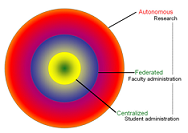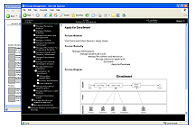Agile Business Architecture Research is an ongoing program in pursuit of knowledge to develop an agile enterprise and business architecture to enable organizations to be responsive to change.
The research scope of business architecture spans the development of strategies in response to the business environment to the underlying structures that enable the implementation of strategies. This includes detailed business and systems analysis and design. In relation to Enterprise Architecture, business architecture primarily deals with:
- Strategic goals, objectives, and strategies
- Business rules and measures
- Information requirements
Business architecture is closely associated with program and change management, governance, maturation and organisational development. If information is a fundamental building block of business architecture then business processes represent the organic network. The hierarchichal and network model of business processes evolves as the organic vine that binds various business and technology elements.
Agility in Business through Strategic Alignment
Rapid changes in our global environment and in technological innovation has placed increasing demands on businesses to be more agile or responsive to change. This agility is facilitated by both business process automation and human-centric values and effective teams. Agility is measured by the ability to execute strategy through internal alignment.
There are 3 focus areas of interest to us in the relationship between business architecture and strategic alignment.
- Strategic Framework - The development of a strategic framework represents the structure on which strategic planning and the formulation of statements (goals, objectives, targets, outcomes, impacts, etc.) is based. It also provides for a holistic method of performance management and results based monitoring and evaluation. This can be applied to public and private enterprises in policy formulation or strategic planning and implementation.
- Strategic Mapping - Strategic mapping ensures that strategies cascade and are associate with all relevant business elements such as programs, projects, business processes, capital investments, operations, organisational development and human capital development.
- Strategic Alignment - Strategic alignment involves implementation and control. This includes corrective action, improvement and maturation.
Central, Federated and Autonomous Organizational Structures
 Organizational structures and processes constantly change in response to strategy. How is this effectively managed?
There are ongoing cycles of centralization, federation and autonomy within business enterprises.
This impacts people, processes and systems requiring cooperation, coordination, integration and synchronization.
A governance framework is developed to enable the compliance and standardization to achieve a quality outcome.
Developing a framework of values, principles and practices compliments the formulation of policies, procedures and
standards to ensure compliance and delivery of quality. Change management and risk management also play their part.
Organizational structures and processes constantly change in response to strategy. How is this effectively managed?
There are ongoing cycles of centralization, federation and autonomy within business enterprises.
This impacts people, processes and systems requiring cooperation, coordination, integration and synchronization.
A governance framework is developed to enable the compliance and standardization to achieve a quality outcome.
Developing a framework of values, principles and practices compliments the formulation of policies, procedures and
standards to ensure compliance and delivery of quality. Change management and risk management also play their part.
Ongoing changes in the legislative environment, industry and technology and ways in which enterprises can manage this change is an area of interest to the development of the business architecture. What would any sport be without referees and players? Key to an effective and enabling business architecture is the structures representing governance and organisation. Technology is no substitute for organisational and human capacity and will not guarantee success. Organisational development and human capital development is integral to building capacity for the delivery of services.
Sector Based Business Process Hierarchies
 The business process architecture represents the cohesion between the business architecture elements: strategic objectives,
indicators, organisation, human, information, systems and technology.
Business process modeling is an important skill that is taught at an undergraduate level.
This forms a critical part of the program for developing skills.
Modeling techniques and methods such as the Business Process Modeling Notation (BPMN) are applied in process and information specification.
We do research into sector based business processes to develop business process hierarchies linked to the approaches developed
by Kaplan and Norton on the Balance Scorecard, Alignment and Strategy Mapping.
The business process architecture represents the cohesion between the business architecture elements: strategic objectives,
indicators, organisation, human, information, systems and technology.
Business process modeling is an important skill that is taught at an undergraduate level.
This forms a critical part of the program for developing skills.
Modeling techniques and methods such as the Business Process Modeling Notation (BPMN) are applied in process and information specification.
We do research into sector based business processes to develop business process hierarchies linked to the approaches developed
by Kaplan and Norton on the Balance Scorecard, Alignment and Strategy Mapping.
Agile Practice
Agile practice is human-centric and involves the development of effective teams and communication. It challenges many established business traditions such as formal project management using waterfall phases and process-centric structures. It places emphasis on people over process and is more open to change and transperancy. We believe that agile is in harmony with a broader postmodern movement towards more natural ways of working and human interaction.